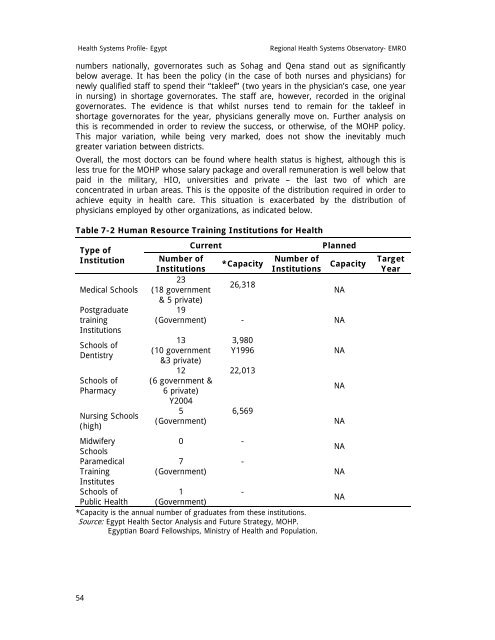Egypt : Complete Profile - What is GIS - World Health Organization
Egypt : Complete Profile - What is GIS - World Health Organization
Egypt : Complete Profile - What is GIS - World Health Organization
Create successful ePaper yourself
Turn your PDF publications into a flip-book with our unique Google optimized e-Paper software.
<strong>Health</strong> Systems <strong>Profile</strong>- <strong>Egypt</strong> Regional <strong>Health</strong> Systems Observatory- EMRO<br />
numbers nationally, governorates such as Sohag and Qena stand out as significantly<br />
below average. It has been the policy (in the case of both nurses and physicians) for<br />
newly qualified staff to spend their “takleef” (two years in the physician’s case, one year<br />
in nursing) in shortage governorates. The staff are, however, recorded in the original<br />
governorates. The evidence <strong>is</strong> that whilst nurses tend to remain for the takleef in<br />
shortage governorates for the year, physicians generally move on. Further analys<strong>is</strong> on<br />
th<strong>is</strong> <strong>is</strong> recommended in order to review the success, or otherw<strong>is</strong>e, of the MOHP policy.<br />
Th<strong>is</strong> major variation, while being very marked, does not show the inevitably much<br />
greater variation between d<strong>is</strong>tricts.<br />
Overall, the most doctors can be found where health status <strong>is</strong> highest, although th<strong>is</strong> <strong>is</strong><br />
less true for the MOHP whose salary package and overall remuneration <strong>is</strong> well below that<br />
paid in the military, HIO, universities and private – the last two of which are<br />
concentrated in urban areas. Th<strong>is</strong> <strong>is</strong> the opposite of the d<strong>is</strong>tribution required in order to<br />
achieve equity in health care. Th<strong>is</strong> situation <strong>is</strong> exacerbated by the d<strong>is</strong>tribution of<br />
physicians employed by other organizations, as indicated below.<br />
Table 7-2 Human Resource Training Institutions for <strong>Health</strong><br />
Type of<br />
Institution<br />
Medical Schools<br />
Postgraduate<br />
training<br />
Institutions<br />
Schools of<br />
Dent<strong>is</strong>try<br />
Schools of<br />
Pharmacy<br />
Nursing Schools<br />
(high)<br />
Midwifery<br />
Schools<br />
Paramedical<br />
Training<br />
Institutes<br />
Schools of<br />
Public <strong>Health</strong><br />
54<br />
Number of<br />
Institutions<br />
23<br />
(18 government<br />
& 5 private)<br />
19<br />
(Government)<br />
13<br />
(10 government<br />
&3 private)<br />
12<br />
(6 government &<br />
6 private)<br />
Y2004<br />
5<br />
(Government)<br />
Current Planned<br />
*Capacity<br />
26,318<br />
Number of<br />
Institutions<br />
Capacity Target<br />
Year<br />
NA<br />
- NA<br />
3,980<br />
Y1996 NA<br />
22,013<br />
6,569<br />
0 -<br />
7<br />
(Government)<br />
1<br />
-<br />
(Government)<br />
*Capacity <strong>is</strong> the annual number of graduates from these institutions.<br />
Source: <strong>Egypt</strong> <strong>Health</strong> Sector Analys<strong>is</strong> and Future Strategy, MOHP.<br />
<strong>Egypt</strong>ian Board Fellowships, Min<strong>is</strong>try of <strong>Health</strong> and Population.<br />
-<br />
NA<br />
NA<br />
NA<br />
NA<br />
NA

















